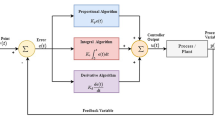Abstract
In this paper, a simple and effective PI controller tuning method is presented. To take both performance requirements and robustness issues into consideration, the design technique is based on optimization of load disturbance rejection with a constraint either on the gain margin or phase margin. In addition, a simplified form of the resulting tuning formulae is obtained for first order plus dead time models. To demonstrate the ability of the proposed tuning technique in dealing with a wide range of plants, simulation results for several examples, including integrating, non-minimum phase and long dead time models, are provided.











Similar content being viewed by others
Abbreviations
- \(A_{m}\) :
-
Desired gain margin
- d :
-
Load disturbance signal
- FOPDT:
-
First order plus dead time
- GM:
-
Gain margin
- \(G_{c}(s)\) :
-
Controller transfer function
- \(G_{p}(s)\) :
-
Plant transfer function
- IAE:
-
Integral of absolute error
- IE:
-
Integral of error
- \(K_{c}\) :
-
Proportional gain
- \(K_{i}\) :
-
Integral gain
- \(K_{p}\) :
-
Gain of FOPDT model
- L(s):
-
Loop transfer function
- PID:
-
Proportional–integral–derivative
- PM:
-
Phase margin
- \(\phi _m\) :
-
Desired phase margin
- r :
-
Reference signal
- SGM:
-
Specified gain margin
- SPM:
-
Specified phase margin
- T :
-
Time constant of FOPDT model
- \(T_{i}\) :
-
Integral time
- \(\tau _d\) :
-
Time delay of FOPDT model
- \(\omega \) :
-
Frequency
- y :
-
Output signal
References
Deshpande PB (1989) Multivariable process control. ISA, RTP, North Carolina
Koivo HN, Tanttu JT (1991) Tuning of PID controllers: survey of SISO and MIMO techniques. In: Proceedings of intelligent tuning and adaptive control, Singapore
Åström KJ, Hagglund T (1995) PID controllers: theory, design and tuning. Instrument Society of America, North Carolina
Bialkowski WL (1993) Dreams versus reality, a view from both sides of the gap. Pulp Pap Can 94(11):19–27
Desbourough L, Miller R (2002) Increasing customer value of industrial control performance monitoring-Honeywell’s experience. In: Proceedings of 6th international conference on chemical process control, AIChE symposium, 98 (326)
Fruehauf PS, Chien IL, Lauritsen MD (1994) Simplified IMC-PID tuning rules. ISA Trans. 33:43–59
Åström KJ, Panagopoulos H, Hagglund T (1998) Design of PI controllers based on non-convex optimization. Automatica 34(5):585–601
Åström KJ, Hägglund T (2004) Revisiting the Ziegler–Nichols step response method for PID control. J Process Control 14:635–650
Skogestad S (2003) Simple analytic rules for model reduction and PID controller tuning. J Process Control 13:291–309
Åström KJ, Hägglund T (2006) Advanced PID control. ISA, Pittsburgh
Cominos P, Munro N (2002) PID controllers: recent tuning methods and design to specification. IEE Proc Control Theory Appl 149(1):46–53
Tavakoli S, Fleming PJ (2003) Optimal tuning of PI controllers for first order plus dead time/long dead time models using dimensional analysis. In: Proceedings of the European control conference, Cambridge, UK
Tavakoli S, Griffin I, Fleming PJ (2007) Multi-objective optimization approach to the PI tuning problem. In: IEEE congress on evolutionary computation, pp 3165–3171
McMillan GK (2014) Tuning and control loop performance. Momentum Press, New York
Marlin TE (2000) Process control: designing processes and control systems for dynamic performance. McGraw-Hill, New York
Seborg DE, Mellichamp DA, Edgar TF, Doyle FJ (2010) Process dynamics and control. Wiley, New York
Smith CA, Corripio AB (2006) Principles and practice of automatic process control. Wiley, Hoboken
Ho WK, Gan OP, Tay EB, Ang EL (1996) Performance and gain and phase margins of well-known PID tuning formulae. IEEE Trans Control Syst Technol 4(4):473–477
Tavakoli, S, Griffin I, Fleming PJ (2005) Robust PI controller for load disturbance rejection and setpoint regulation. In: Proceedings of IEEE international conference on control applications, Canada
Zlokarnik M (1991) Dimensional analysis and scale-up in chemical engineering. Springer, Berlin
Author information
Authors and Affiliations
Corresponding author
Rights and permissions
About this article
Cite this article
Tavakoli, S., Sadeghi, J., Griffin, I. et al. PI controller tuning for load disturbance rejection using constrained optimization. Int. J. Dynam. Control 6, 188–199 (2018). https://doi.org/10.1007/s40435-016-0290-6
Received:
Revised:
Accepted:
Published:
Issue Date:
DOI: https://doi.org/10.1007/s40435-016-0290-6




